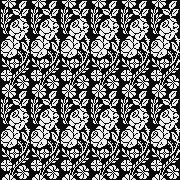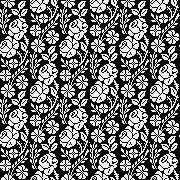Electronic pattern books now available for free online often include images of mylars or of files for knitting using specific machine models and/or accessories.
The designs may be used as provided or serve as springboards for DIY variations.
Some knitters prefer large-scale designs in non-repetitive patterns on garment pieces.
Roses and houndstooth designs reappear frequently on runways. This was included in a Studio pub and caught my eye. 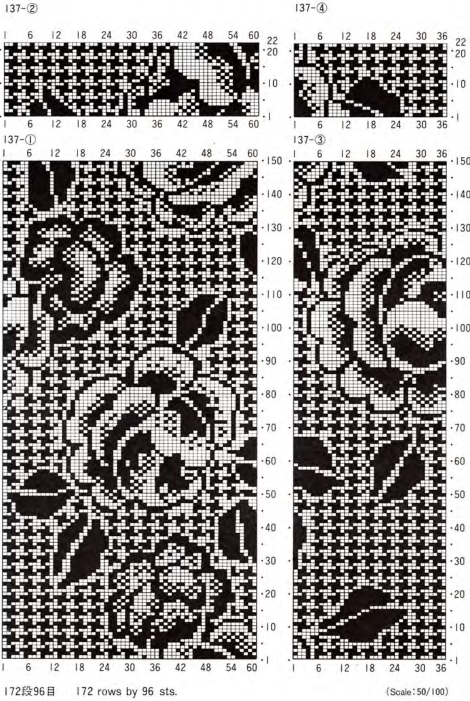 Conversion to the full 96X172 file.
Conversion to the full 96X172 file. Visualizing the potential large piece knit, it was not an instant favorite.
Visualizing the potential large piece knit, it was not an instant favorite. 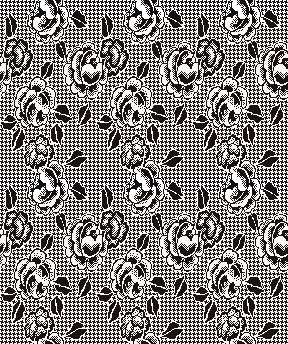 Working towards a DIY design and examining varied methods and steps:
Working towards a DIY design and examining varied methods and steps:
the inspired 4-stitch brush to be used in the background fills  a small “rose” from a punchcard repeat, 24X24
a small “rose” from a punchcard repeat, 24X24![]() the first approach uses color to alpha to place the design on a pattern-filled ground, the file is adjusted to 30X30 to allow for outlining the rose in a third color
the first approach uses color to alpha to place the design on a pattern-filled ground, the file is adjusted to 30X30 to allow for outlining the rose in a third color ![]() the result, in turn, is centered on a 44X44 new image.
the result, in turn, is centered on a 44X44 new image.
To have the white pixels forming the petals undisturbed when using color to alpha, the background is changed to cyan ![]() in a new window, fill a new picture, 44X44, with pattern
in a new window, fill a new picture, 44X44, with pattern ![]() copy and paste the flower, anchoring it in place after rendering the cyan transparent
copy and paste the flower, anchoring it in place after rendering the cyan transparent ![]() and change the magenta outline to white,
and change the magenta outline to white, ![]() tile to 132X132
tile to 132X132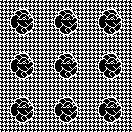 playing with the movement of the shapes to change the overall placement, the brick repeat immediately shows patterning problems, and the shapes appear small
playing with the movement of the shapes to change the overall placement, the brick repeat immediately shows patterning problems, and the shapes appear small  the 30-pixel file is doubled in size to 60X60,
the 30-pixel file is doubled in size to 60X60,  check that the number of colors is set to 3, fill the white background with pattern
check that the number of colors is set to 3, fill the white background with pattern  magenta pixels to white
magenta pixels to white 
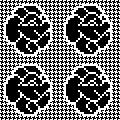 the intersection problem in a standard brick repeat reoccurs
the intersection problem in a standard brick repeat reoccurs 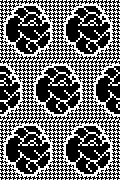 if the white outline is considered too thick, reduce it to one pixel from 2.
if the white outline is considered too thick, reduce it to one pixel from 2.
In this 60X60 image, the lines forming the petals are also colored in magenta, and the outline is reduced from 2 pixels to 1,  Changing the approach: the above is drawn in repeat on a white ground. Rotating any individual elements becomes possible with no disruption in the yet-to-be brush-filled design.
Changing the approach: the above is drawn in repeat on a white ground. Rotating any individual elements becomes possible with no disruption in the yet-to-be brush-filled design. 
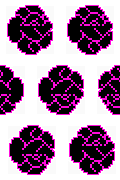 Filling in the white ground with the pattern results in no tiling errors
Filling in the white ground with the pattern results in no tiling errors 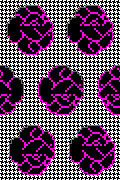 eliminating the third color, BW brick, it is not possible to isolate a smaller repeat
eliminating the third color, BW brick, it is not possible to isolate a smaller repeat 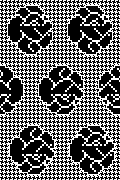 keeping directions constant in alternate rows of the pattern
keeping directions constant in alternate rows of the pattern  makes isolating the smallest repeat possible, 60X120.
makes isolating the smallest repeat possible, 60X120.
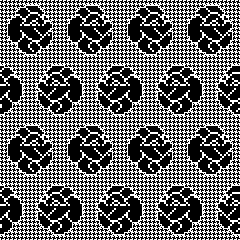 Back to the inspiration florals, isolating one of the roses, 61X59, note that the shape is not symmetrical
Back to the inspiration florals, isolating one of the roses, 61X59, note that the shape is not symmetrical  with a single-pixel third color outline, on a white ground, 64X64
with a single-pixel third color outline, on a white ground, 64X64 tiled in a simple brick repeat to 128X192 on a white ground
tiled in a simple brick repeat to 128X192 on a white ground 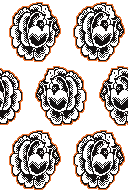 with the background pattern-filled
with the background pattern-filled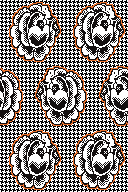 64X128 isolated smallest repeat
64X128 isolated smallest repeat 
 tiled in BW with colored outline removed
tiled in BW with colored outline removed 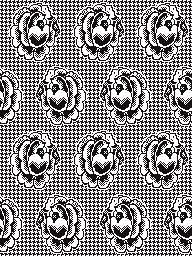 testing random placements
testing random placements 
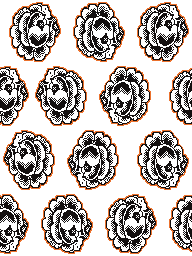 produce a design with the smallest programmable repeat
produce a design with the smallest programmable repeat 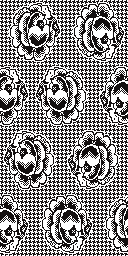 note that the horizontal distance between the flower shapes is not fixed
note that the horizontal distance between the flower shapes is not fixed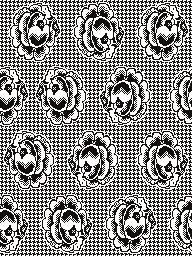
seeking symmetry 50X58  scaled to 58X58
scaled to 58X58 planning added borders 64X64
planning added borders 64X64  outlined
outlined  a full single repeat 192X256 using the same random arrangement
a full single repeat 192X256 using the same random arrangement 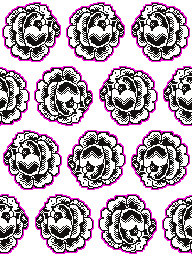
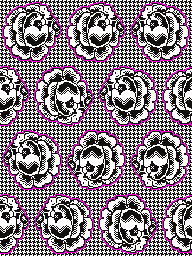
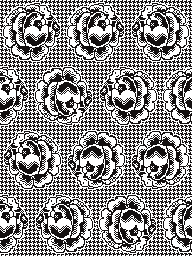 building the smallest straightforward single brick repeat if there are limitations on the size of the programmed image ie to avoid multiple tracks in machines such as the 930 using img2track
building the smallest straightforward single brick repeat if there are limitations on the size of the programmed image ie to avoid multiple tracks in machines such as the 930 using img2track 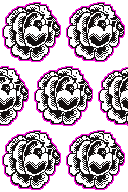


 the slightly scaled design reduced to an 80X80 repeat to play with in any configuration of your choice.
the slightly scaled design reduced to an 80X80 repeat to play with in any configuration of your choice.  The test swatch for the full single repeat
The test swatch for the full single repeat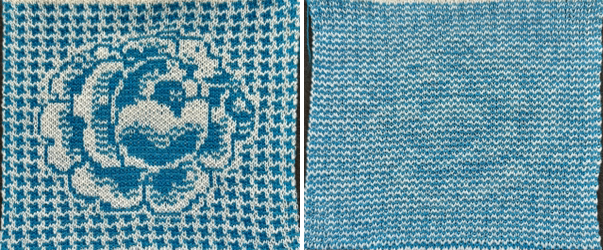 Continuing on a floral theme, inspired by a filet crochet design, 30X90
Continuing on a floral theme, inspired by a filet crochet design, 30X90 ![]() its half drop version, 60X90
its half drop version, 60X90 drawing both in repeat to 180X180 helps to determine whether further editing is needed, and if the shift in vertical/horizontal vs diagonal striping is preferred
drawing both in repeat to 180X180 helps to determine whether further editing is needed, and if the shift in vertical/horizontal vs diagonal striping is preferred 